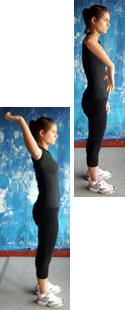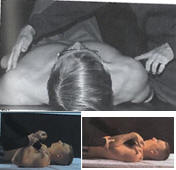Mobility Evaluation
Joint mobility of one movement is most of the time restricted by the other
movement of the pair. The test are classified here by joint movment but
test in fact the flexibility of the main movers of the opposite movement.
Ankle
Plantarflexion and Dorsiflexions
Inversion
and Eversion
Each motion can be assessed with the athlete supine (lying on his back) on the
examination table. Also perform the
evaluation of dorsiflexion with the knee bent at 90°, either in supine position
or sitting. The athlete is asked to
first move the ankle to the desired position and the therapist can apply passive
over-pressure to the joint to assure full range. Both sides should be tested for
comparison and only measured if one side is drastically different from the
other.
Normal range of motion: Dorsiflexion
1-joint: 20°
2-joints: 10°
Plantarflexion:
50° Eversion:
5-15°
Inversion:
20-30°
Video:
https://youtu.be/d5NpnkkMd4Q
Knee
Extension
Lie supine on mat or bench. Bend hip and knee at right angles so thigh is
vertical and lower leg is horizontal. Starting position shown.
Extend knee and hold position. Repeat on opposite leg.
Angle of knee is noted. Achieving a 5° to 15° bend is desirable.
Ankle may be kept in neutral position or plantar flexed (pointed). Thigh
may be stabilized vertically by test administrator or subject using a mirror.
Normal range of motion: 0° (fully open)
Flexion
Lie prone on bench, floor, or mat. Flex one knee.
Test administrator gently pushes heel of bent leg toward buttocks until
resistance is felt or partner expresses discomfort. Repeat on opposite leg.
Pelvis should remain on floor with no flexion at hip. If hip flexes while
knee is flexed, a tightness in the Rectus Femoris is indicated. Knee should bend
freely 135° or heel should touch buttocks
Normal range of motion: 140°
Hip
Extension
Lie supine on bench with leg extended beyond edge of bench (less than half of
thigh on bench). Bring knee of other leg to chest.
Pull thigh down with hands until low
back touches testing surface. Repeat on opposite leg.
With
low back and sacrum flat to the table, thigh should touch the table (knee bends
to 80° if 2-joints flexors are normal).
If the knee bends at less than 80°, it is an indication of short 1 joint
flexors.
Thigh should be pulled into chest just enough to have low back contact bench. A
false positive may occur if pelvis posteriorly rotates beyond what is necessary
to have low back contact testing surface.
Normal range of motion: 1-joint -10°, 2-joints 10°
Flexion
Supine position; Legs extended, sacrum and low back flat to table; Prevent
pelvic tilt; Raise one leg with the leg straight and foot relaxed; If knee
starts to bend, lower the leg and straighten then move again
Normal length produces 80° between the table and the raised leg is considered
normal for the 2-joints test. Flex teh knee and repeat the test for
the 1-joint test.
Normal range of motion: 1-joint 130°, 2-joints 80-90°
Adduction
Lie on mat or bench on side with lower leg bent 90° at hip and knee. Test
administrator grasps upper leg above ankle and places hip in neutral position
(no flexion nor hyperextension) and knee at 90°.
Weight of upper leg is allowed to lower toward testing surface. Repeat on
opposite leg.
Test administrator places fingers between testing surface and medial femoral
condyle. Score using number of finger breadths.
Normal range of motion: 20-30°
Thorax
Flexion
Sit on floor or mat with knees straight. Reach
toward or beyond toes or bring torso toward legs. Hold position. The quality of
the stretch should be examined for smoothness of spinal curve and the angle of
hip (near 90° or more).
Feet may be plantar flexed or placed against box, but protocol/norms must be
kept consistent for comparisons since ankle
position can affect hip flexion performance.
Normal range of motion: 50°
Extension
Lie prone on mat or floor with arms down by sides.
Slow raise torso as high as possible. Head looks forward, horizontal to
floor. Height of chin from floor is noted. Most individuals should be
able to raise the chin at least 6 inches (15 cm).
It should be noted that individuals with longer trunks may be able to score
better.
Normal range of motion: 0°
Rotation
Lie supine on floor or mat with knees and hip bent at right angles.
Lower legs to floor to right, then to
left. Repeat on opposite leg. Shoulders
should remain in contact with floor during movement. Adequate rotation of spine
(lumbar and thoracic junction) is demonstrated if shoulders remain in contact
with floor while both sides of legs make contact with floor.
Normal range of motion: 30°
Shoulder
Flexion
Raise both arms in flexion overhead, keeping them close to the head and a flat
low back. Measure the angle between the
humerus and the table or inches between table and lateral epicondyle.
Short if the arms cannot reach table.
Normal range of motion:
Extension
Standing or lying on the side of a table, bring the arm in a full extension
keeping the arm straight. It is short if
it does not reach an angle of °
between the humerus and the trunk.
Normal range of motion:
Horizontal Adduction
Standing, sitting, or lying on the side of a table, bring the arm in a full
horizontal extension, keeping the arm straight and the hand at elbow hight.
It is short if it does not reach an angle of 35° between the humerus and the trunk.
Normal range of motion: 45°

Horizontal Abduction
Standing, sitting, or lying on the side of a table, bring the arm in a full
horizontal flexion, keeping the arm straight and the hand at elbow hight.
It is short if it does not reach an angle of 125° between the humerus and the trunk.
Normal range of motion: 135°
Internal rotation
Stand or sit. Position bent arm up to side; elbow bent shoulder height with
wrist in front of elbow. Lower wrist
down/back as far as possible while keeping elbow directly lateral to shoulder.
Repeat with opposite arm. Wrist should
be able to travel below transverse plane of shoulder. The distance wrist travels
below shoulder or range of motion is noted for each side.
Elbow must be kept squarely lateral to shoulder for consistent assessment
protocol. A mirror may help monitor proper form and assist in a more accurate
assessment. Note any pain or discomfort during movement.
Normal range of motion: 70°
External rotation
Stand or sit. Position bent arm up to side; elbow bent shoulder height with
wrist above elbow. Pull wrist back as
far as possible while keeping elbow directly lateral to shoulder. Repeat with
opposite arm. Wrist should be able to
travel slightly behind frontal plane of shoulder. The distance wrist travels
behind shoulder or range of motion is noted in each side.
Keep elbow squarely lateral to shoulder for consistent assessment protocol. A
mirror may help monitor proper form and assist in a more accurate assessment.
Note any pain or discomfort during movement.
Normal range of motion: 90°
Scapula retraction
Subject lays supine with arms at their side.
Shoulder will be raised off the table and may resist downward pressure if
the flexors are short.
Maintain pressure on the anterior shoulder region. Bend elbow into full flexion.
This will remove the tension from the biceps.
Then lift elbow 6-8 inches. This removes
the tension from the Coracobrachialis.














